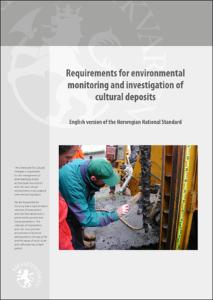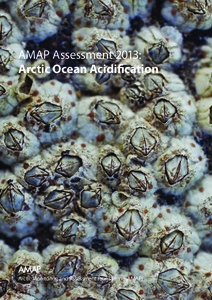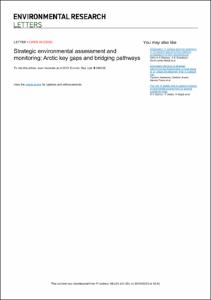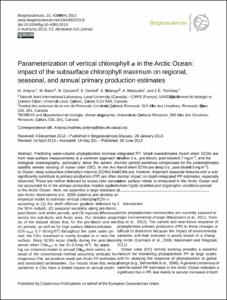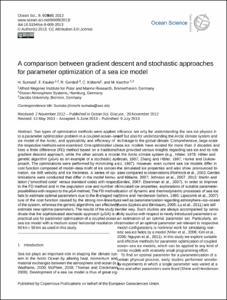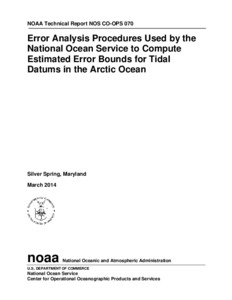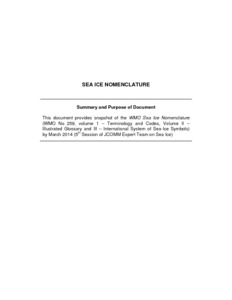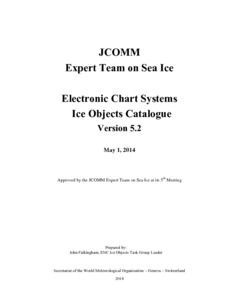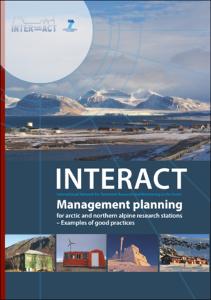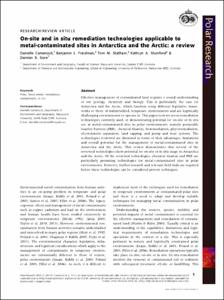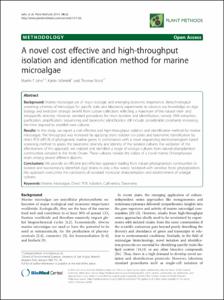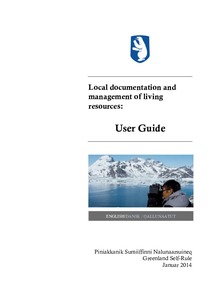Browsing CAPARDUS Practices by Issue Date
Now showing items 21-40 of 244
-
Management and utilization of seals in Greenland. Revised April 2012.
(Government of Greenland, Department of Fisheries, Hunting & Agriculture, Greenland, 2012)1. Species: There are six different species of seals in the Greenlandic waters. Five of the species have been hunted for centuries, but today the catch is focused on the harp seal, ringed seal and hooded seal with great ... -
Requirements for environmental monitoring and investigation of cultural deposits: English version of the Norwegian National Standard.
(Norwegian Directorate for Cultural Heritage [Riksantikvaren], Oslo, Norway, 2012)This standard is based on the Norwegian Directorate for Cultural Heritage’s [Riksantikvaren] strategy for monitoring of subsurface deposits of archaeological or cultural significance (“cultural deposits”) and on the guidance ... -
Inverse modelling of cloud-aerosol interactions - Part 2: Sensitivity tests on liquid phase clouds using a Markov chain Monte Carlo based simulation approach.
(2012)This paper presents a novel approach to investigate cloud-aerosol interactions by coupling a Markov chain Monte Carlo (MCMC) algorithm to an adiabatic cloud parcel model. Despite the number of numerical cloud-aerosol ... -
White paper on management and utilization of large whales in Greenland. [Presented at the 63rd Annual Meeting of the International Whaling Commission].
(Government of Greenland, Ministry of Fisheries, Hunting & Agriculture, Greenland, 2012)Within the IWC context, Greenland’s hunt of large whales falls in the category of Aboriginal Subsistence Whaling (ASW) together with the whaling of the Russian Federation, St. Vincent and The Grenadines and the USA. For ... -
AMAP Assessment 2013: Arctic Ocean Acidification.
(Arctic Monitoring and Assessment Programme (AMAP), Oslo, Norway, 2013)This assessment report presents the results of the 2013 AMAP Assessment of Arctic Ocean Acidification (AOA). This is the first such assessment dealing with AOA from an Arctic-wide perspective, and complements several ... -
Observing System Simulation Experiments; justifying new Arctic observation capabilities.
(NOAA National Centers for Environmental Prediction, 2013)The Arctic is recognized as one of the key areas of the globe, both in terms of its sensitivity to climate change, and by the increasing economic activity that is expected with the opening up of Arctic areas in a warming ... -
Incorporating Inuit Societal Values.
(Government of Nunavut, Nunavut, 2013)This report is a compilation of the Government of Nunavut’s activities that reflect Inuit Qaujimajatuqangit (IQ) and Inuit Societal Values (ISV). The first section of the report identifies legislation with references to ... -
The right to food security in a changing Arctic: the Nunavut Food Security Coalition and the Feeding My Family campaign.
(Irish Aid, Mary Robinson Foundation: Climate Justice CGIAR Research Program on Climate Change, Agriculture and Food Security (CCAFS) and World Food Programme., 2013)In Nunavut in the Canadian Arctic, Inuit are mobilising themselves and their government to address rising food prices and food insecurity; focusing on the right to a traditional way of life and the challenges brought by ... -
Strategic environmental assessment and monitoring: Arctic key gaps and bridging pathways.
(2013)The Arctic region undergoes rapid and unprecedented environmental change. Environmental assessment and monitoring is needed to understand and decide how to mitigate and/or adapt to the changes and their impacts on society ... -
Parameterization of vertical chlorophyll a in the Arctic Ocean: impact of the subsurface chlorophyll maximum on regional, seasonal, and annual primary production estimates.
(2013)Predicting water-column phytoplankton biomass from near-surface measurements is a common approach in biological oceanography, particularly since the advent of satellite remote sensing of ocean color (OC). In the Arctic ... -
A comparison between gradient descent and stochastic approaches for parameter optimization of a sea ice model.
(2013)Two types of optimization methods were applied to a parameter optimization problem in a coupled ocean-sea ice model of the Arctic, and applicability and efficiency of the respective methods were examined. One optimization ... -
Error Analysis Procedures Used by the National Ocean Service to Compute Estimated Error Bounds for Tidal Datums in the Arctic Ocean.
(NOAA, NOS Center for Operational Oceanographic Products and Services, Silver Spring, MD, 2014)NOAA has an established National Water Level Observation Network (NWLON) along all U.S. coastlines. One purpose of the NWLON is to provide control for tidal datum determination at short-term water level stations ... -
Sea-Ice Nomenclature: snapshot of the WMO Sea Ice Nomenclature (WMO No. 259, Volume 1 – Terminology and Codes, Volume II – Illustrated Glossary and III – International System of Sea-Ice Symbols)
(WMO-JCOMM, Geneva, Switzerland, 2014)This document provides snapshot of the WMO Sea Ice Nomenclature (WMO No. 259, Volume 1 – Terminology and Codes, Volume II – Illustrated Glossary and III – International System of Sea-Ice Symbols) by March 2014 (5th Session ... -
Electronic Chart Systems Ice Objects Catalogue Version 5.2, 2014 edition
(WMO/JCOMM Expert Team on Sea Ice, Geneva, Switzerland, 2014)Electronic Navigation Charts (ENC) and Electronic Chart Display and Information Systems (ECDIS) are becoming widely available on ships navigating in icy waters and it is necessary to provide ice data in a form that can be ... -
The Sea Ice Never Stops: Circumpolar Inuit Reflections on Sea Ice Use and Shipping in Inuit Nunaat.
(Inuit Circumpolar Council, Anchorage, AK, 2014)This report from the Inuit Circumpolar Council (ICC) contributes to the ongoing work of the Sustainable Development Working Group and the Protection of the Arctic Marine Environment working groups of the Arctic Council. ... -
Ice Chart Colour Code Standard, Version 1.0, 2014.
(World Meteorological Organization & Intergovernmental Oceanographic Commission, Geneva, Switzerland, 2014)This document describes two separate colour codes for use on ice charts: the first one based on total concentration (CT) intended for use when the stage of development is relatively uniform but concentration is highly ... -
INTERACT Management planning for Arctic and northern alpine research stations – Examples of good practices.
(Aarhus University, DCE – Danish Centre for Enviroment and Energy, Aarhus, Denmark, 2014)This book is about management of arctic and northern alpine research stations. It has been produced by a group of station managers participating in the EU 7th Framework Programme Infrastructure project called INTERACT. ... -
On-site and in situ remediation technologies applicable to metal-contaminated sites in Antarctica and the Arctic: a review.
(2014)Effective management of contaminated land requires a sound understanding of site geology, chemistry and biology. This is particularly the case for Antarctica and the Arctic, which function using different legislative ... -
A novel cost effective and high-throughput isolation and identification method for marine microalgae.
(2014)Background: Marine microalgae are of major ecologic and emerging economic importance. Biotechnological screening schemes of microalgae for specific traits and laboratory experiments to advance our knowledge on algal biology ... -
Local documentation and management of living resources: User Guide. [PISUNA Manual]
(Piniakkanik sumiiffinni nalunaarsuineq (PISUNA), Nuuk, Greenland, 2014)Welcome to Greenland Self-Government’s Guide to Local Documentation and Management of Living Resources! This guide is intended to help citizens document and interpret changes in living resources. The guide has been written ...
 Repository of community practices in Ocean Research, Applications and Data/Information Management
Repository of community practices in Ocean Research, Applications and Data/Information Management

